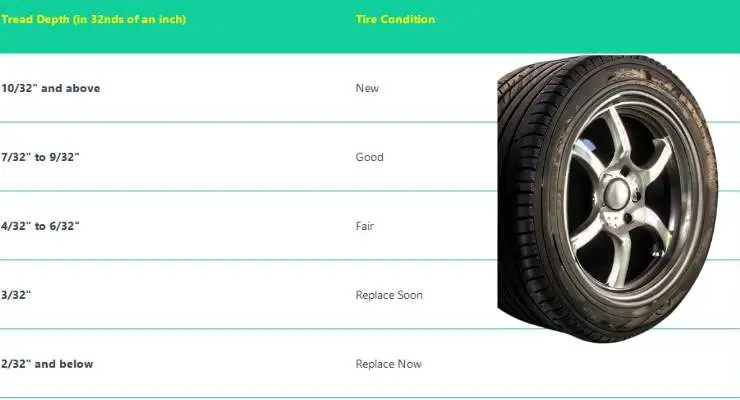Every time you hit the road, your tires take you to your destination. But, how often do you consider their condition? One crucial aspect to monitor is the tire tread depth. This handy guide will help you navigate the importance and usage of a tire depth chart.
Tire Depth Chart
A tire depth chart is usually a simple table that lists the depth of the tire tread and the associated condition of the tire. Here is a simple example:
| Tread Depth (in 32nds of an inch) | Tire Condition |
|---|---|
| 10/32″ and above | New |
| 7/32″ to 9/32″ | Good |
| 4/32″ to 6/32″ | Fair |
| 3/32″ | Replace Soon |
| 2/32″ and below | Replace Now |
Please note, these values can vary depending on the specific type of tire and the driving conditions they’re used under. Always check the manufacturer’s recommendations for your specific tires.
Read More: Can I Drive 200 Miles on a Donut? Safety Tips and Limitations
Importance of Tire Tread Depth
Tire tread depth plays an essential role in your vehicle’s overall performance. It can impact various factors like:
Safety Implications
The depth of your tire tread can greatly affect your vehicle’s stopping distance, particularly on wet surfaces. Tires with good tread depth can disperse water effectively, reducing the risk of hydroplaning.
Fuel Efficiency
Tires with optimal tread depth reduce rolling resistance, which in turn enhances fuel efficiency. Worn-out tires, conversely, can increase fuel consumption.
Road Grip
Tread depth is crucial for maintaining grip, especially on slippery or loose surfaces. Good tread depth allows better traction, improving vehicle control.
Read More: TIRE MILEAGE WARRANTY CALCULATOR: Ease Your Calculations
How to Measure Tire Tread Depth
Understanding how to measure tire tread depth is a vital part of maintaining your vehicle’s health. Here are two common methods:
Using a Tread Depth Gauge
A tread depth gauge is a precise tool that gives accurate measurements. Insert the probe into the groove and read the measurement.
Using a Penny Test
Don’t have a gauge? No worries. The penny test can be a quick and easy way to check your tires. Simply insert a penny into the tread with Lincoln’s head upside down. If you can see all of Lincoln’s head, your tread depth is less than 2/32″, and it’s time to replace your tires.
Read More: How to Get Tires Replaced Under Warranty: A Step-by-Step Guide
Reading a Tire Depth Chart
Understanding the Numbers
A tire depth chart provides tread depth measurements in 32nds of an inch. It can help determine whether your tires are in the “new,” “good,” “fair,” or “replace” category.
When to Replace Your Tires
Minimum Legal Tread Depth
The minimum legal tread depth in many areas is 2/32″ but replacing your tires before they reach this point is often safer.
Signs of Worn Out Tires
Apart from tread depth, watch out for signs of wear and tear such as cracks, bulges, or bald spots.
Read More: How Long Does a Plugged Tire Last? Tips and Recommendations
Choosing the Right Tires
Following factors are are important while choosing a tire.
Terrain
Choose tires that suit the terrain you frequently drive on.
Weather Conditions
The weather conditions in your area can also dictate the type of tires you need.
Vehicle Type
The type and size of your vehicle also influence the kind of tires you should choose.
Tire Maintenance Tips
Maintaining your tires is vital for their longevity and performance.
Regular Checks
Regular checks ensure early detection of any potential issues.
Proper Inflation
Maintaining the right tire pressure is essential as underinflation or overinflation can cause tire wear.
Conclusion
Tire tread depth is a key factor in the safety and performance of your vehicle. Understanding and using a tire depth chart can help you maintain your tires and replace them at the right time, ensuring a safer and more efficient ride.
